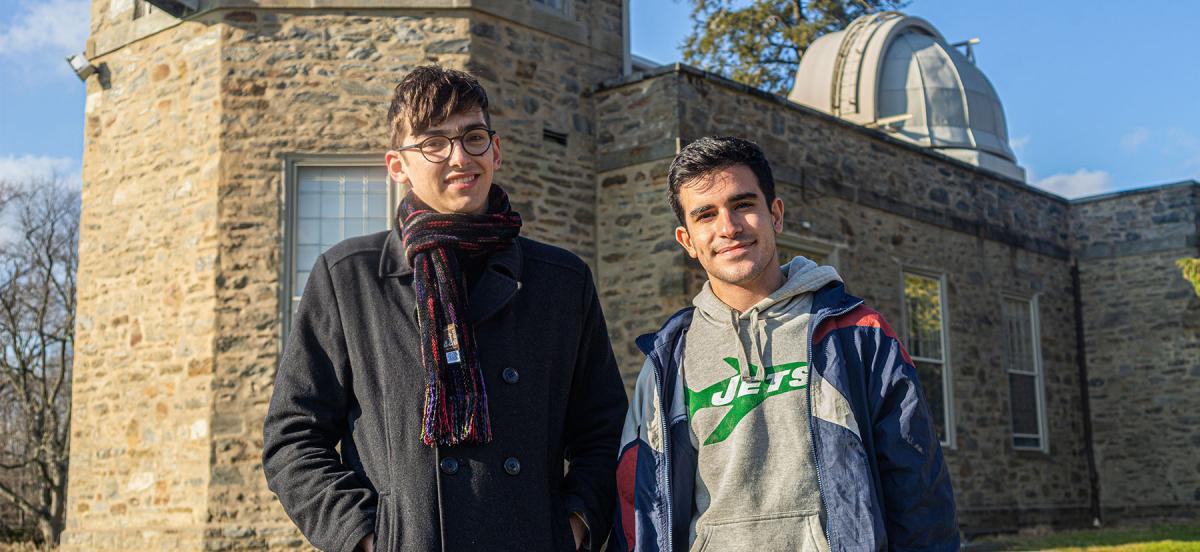Team of Fords Contributes to Best-Ever Pulsar Measurements

(From left) Jesse Zeldes '22 and Sergio Montano '21 were part of a Haverford team, along with Professor of Physics and Astronomy Andrea Lommen, Reilly Milburn ’19, and Research Associate Wyn Ho, that helped measure the mass of a neutron star. Photo by Patrick Montero.
Details
A new paper by Professor and Chair of Physics and Astronomy Andrea Lommen, Reilly Milburn ’19, Sergio Montano ’21, and Jesse Zeldes ’22 measures pulsar timing made observable for the first time by NASA’s Neutron star Interior Composition Explorer (NICER).
Studying the final frontier is no small step for mankind, but Professor and Chair of Physics and Astronomy Andrea Lommen and her students are making giant leaps look easy.
Lommen’s research focuses on neutron stars, an extraterrestrial state of matter that cannot be replicated on earth. Using a high-precision x-ray telescope called the Neutron Star Interior Composition Explorer (NICER) that lives on the International Space Station, Lommen and her students were part of a group of international scientists who were able, for the first time ever, to measure the ratio of the mass to the radius of a neutron star. A recent paper, co-authored with Reilly Milburn ’19, Sergio Montano ’21, Jesse Zeldes ’22, and Haverford Research Associate Wynn Ho, is part of a suite of papers published in The Astrophysical Journal that announced the findings.
“A neutron star is basically a macroscopic nucleus,” said Lommen. “Neutron star material is so dense that one teaspoon of it would weigh as much as all of humanity. The paper that my group is a part of is part of a suite of papers that represents the first measurement of the ‘equation of state’ of neutron star material. In other words, the NICER team just made the first measurement of the pressure and density of neutron star material.”
Lommen leads the timing working group in NICER, a collection of researchers who are interested in what the cadence and length of neutron star pulses can reveal about the dense matter. This new publication is the first in a series about the impact of NICER data for the teams of scientists who use it.

“These papers are a detailed analysis of the pulse shape, but they require excellent timing in order to best detect the pulse shape,” said Lommen, whose students analyzed the NASA data.
How does such astronomical data make its way back down to earth? The students’ analysis is performed via computer programming. The data was downloaded from the International Space Station and stored on a server at NASA Goddard Space Flight Center. The Haverford students transferred the data from Goddard and analyzed it using software that was written, in part, by the NICER science team and, in part, by the students themselves.
“We worked on maintaining and gathering data through the NICER pipeline--the complicated set of procedures through which voltages in detectors on the spacecraft are converted into times of arrivals which can be used for scientific purposes,” said Montano.
Montano and Zeldes began working on this project through summer internships in Lommen’s lab, building upon work begun by Milburn, who is now earning his Ph.D. in physics and astronomy at the University of North Carolina at Chapel Hill. Being published in such a prestigious journal and a part of NASA’s large-scale research is no small feat, and the students look forward to continuing to grow as astrophysicists and researchers.
“It means a lot to us and it is amazing to be a part of this research project because of the exciting new insight that this will bring to the field of pulsar timing,” said Zeldes. “I would love to continue doing research in this field and am fascinated by the fact that we have a neutron star equation of state. This result is only a forebearer of many more exciting properties of neutron stars that could be observed by NICER in future years. I've loved working on the NICER team!”
For Lommen, teaching her students about the world of scientific publishing is an essential part of preparing the next generation of researchers for life beyond Haverford.
“I think it's really important for students to see what the publication process is like,” she said. “I tend to think of it as an endurance test. These manuscripts are scientific records and they need to be precise, complete, and they need to hold up to intense scrutiny. I also think it's really important for students to understand that, to put it bluntly, research doesn't matter until it's in the public record. You can do all sorts of cool things that are totally interesting and thoroughly excite you, but until they're published, nobody knows about them. Publication allows further results to be built upon your discoveries. Publication is what creates knowledge.”

Milburn also shares in his collaborator’s excitement.
“NASA is doing some really cool stuff to forward scientific discovery, and being a part of that discovery through our contribution to this publication truly is a dream come true,” he said. “NASA's space exploration missions within and outside our solar system have been an inspiration to me as an astronomer, and really got me interested in the field in the first place. Now when I wear all the NASA gear I've been accumulating over the years, I can say, ‘I worked with NASA!’ I think that is pretty rad.”



